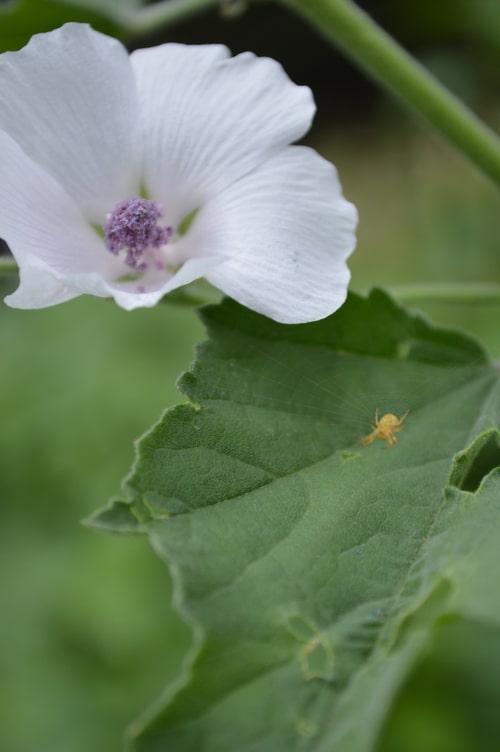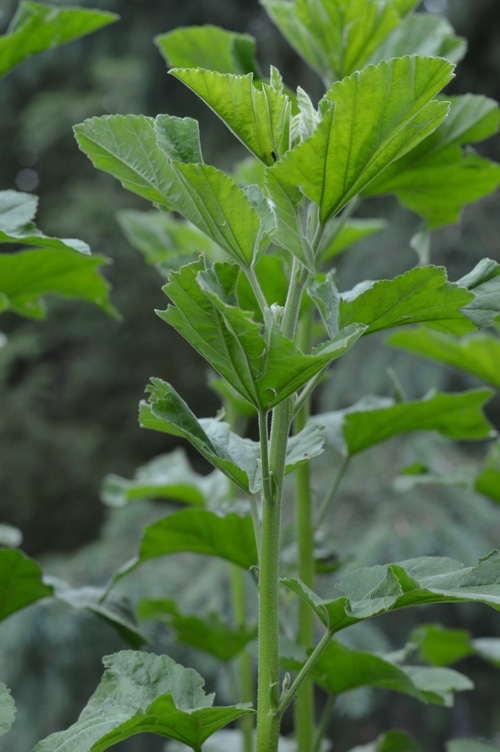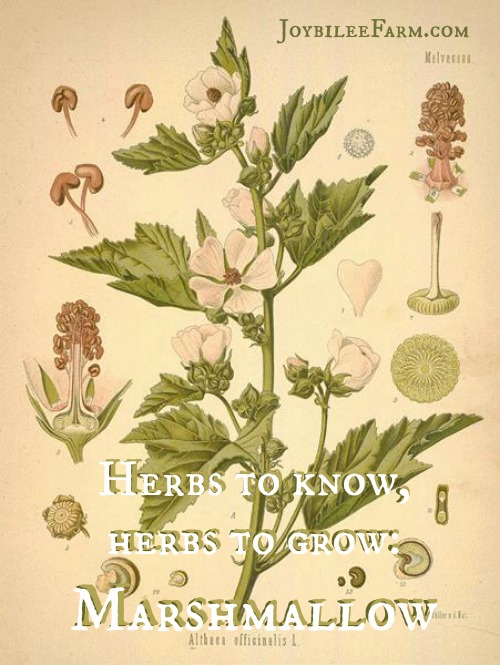Marshmallow (Althea officinalis)
No country herb garden would be complete without marshmallow. It is beneficial for so many ailments from stomach upset, constipation, sore throat, bronchial spasms, and even bruises, cuts, and scrapes. It has a wild, rustic look with its maple-like leaves, and rosey looking flowers, tall and swaying gently in the breezes of summer. Painted lady butterflies are attracted to it. Native pollinators cover its blossoms in summer. You’ll want to find a spot on your homestead for this amazing herb.
Marshmallow (Althea officinalis) is a perennial flowering weed of moist, damp places. It’s soft, hairy stock stands 3 to 4 feet high. It has a branched stem. It’s soft, hairy leaves are deeply cut in 3 divisions, similar in shape to a maple leaf. The flowers are born along the upper stalk. They have 5 heart shaped petals, usually white, to bluish pink or mauve. They bloom in late summer. Flowers, leaves, and root are edible.

The root is many branched with none being thicker than a pencil. While the root contains the most mucilage, even the leaves have a high percentage of the it – the sweet, viscous liquid that gives old fashioned marshmallows their light, airy texture. (Learn how to harvest marshmallow root here.)
Use the leaves and flowers as poultices to soothe skin irritations, bruising, and irritation. Make a tea of the leaves and flowers for bronchitis, and cough. The roots contain more than 30% mucilage that is soothing to mucus membranes and the digestive tract. The leaves in early spring, make a mild tasting, and healthful salad.

Growing marshmallow in the garden
Marshmallow is a common flower in cottage gardens due to its beneficial medicinal qualities. Marshmallow is the plainer cousin of Hollyhock, a tall biennial flower in the mallow family. Since marshmallow is a perennial, you’ll want to put plant it where you want it to grow permanently. It grows to 3 or 4 feet tall, if given plenty of water, so plan for its height, to avoid shadowing smaller plants.
Establishing a planting from root divisions or cuttings
Marshmallow grows from root divisions or cuttings. Cuttings root easily in summer, if the ground is kept damp. Divide the root in fall, after the plant dies down, or in the Spring before the succulent growth comes up. Plant marshmallow in your garden, in a damp spot. Plant it in full sun. It is hardy to zone 3 and thrives in cool to cold areas, where other flowers fail.
Stratify the seeds before planting
Marshmallow can also be grown from seed. If you are beginning a new planting of marshmallow from seed, the seeds need to be stratified by exposing them to cold, damp conditions. In mild winter areas you can plant in the fall to get blossoms in the following summer. In harsh winter areas, plant in the early spring, as soon as the ground can be worked. Marshmallow seeds will germinate as the soil warms up. Keep it well weeded and mulched. Water it when you water your garden. If your season is short, expect flowers in the second year.
You can stratify the seeds naturally by planting them in seed trays in the greenhouse in late fall and letting the natural cold and freezing act on the seeds. You can also stratify them by planting them out in the fall, where you want them to grow. Mark the spot so that you don’t accidently weed them out in your spring garden cleanup.
One variety of marshmallow that is specially selected for abundant mucilage is Erfurt Marshmallow (Althea officinalis ‘Erfurter’ ) available from Richter’s Herbs. Erfurter contains up to 10% medicinal mucilage and is the variety grown in Europe for herbal medicine.
If you are buying the seed from a garden store and you want to plant them out in the garden this spring, you’ll need to stratify them in the fridge. Place the seeds in damp sand or peat and put them all together in a zipper sealed bag. Seal it up well and allow the bag to sit undisturbed for 24 hours. This will allow the seeds to swell. Then place the bag in the refrigerator for 4 to 6 weeks. Check the seeds for signs of growth after a month. When you notice germination, remove the seeds from the fridge and plant them in pots in prepared soil.
Keep the soil evenly moist by covering the pots with a plastic dome to keep them from evaporating. Once the plants have grown two sets of true leaves, you can plant them out in their permanent location. Remember to harden them off, if you’ve been growing them in the house, to avoid transplant shock. If you’ve been growing them in an unheated greenhouse, they should be sufficiently acclimatized.
Plant the seedlings 1 foot apart in rows at the back of a perennial bed. Mulch well to discourage weeds and hold in soil moisture. Keep well watered and well weeded the first year to allow them to become established. You can begin harvesting roots in the 2nd fall after a spring planting.

How to harvest marshmallow
The leaves, flowers, and roots are used in herbal medicine. But the harvest window is different, depending on which part of the plant you are using. At any time you can harvest the leaves to use as a poultice. If you are preserving the leaves, or roots for winter, harvest at the optimal time for each plant part.
Harvest the leaves after flowering. Dry them well. Harvest the root in late fall, before the ground freezes. Clean the roots of root fibers and cork. Chop roots into ½ inch pieces and dry immediately.
Marshmallow root contains 25 to 30% mucilage, pectin, and asparagine (like asparagus). The leaves also contain mucilage.
According to David Hoffman in Holistic Herbal:
“The high mucilage content of Marshmallow makes it an excellent demulcent. The root is used primarily for digestive problems, inflammations of the digestive tract and on the skin, whilst the leaf is used for the lungs and urinary system. For bronchitis, respiratory catarrh and irritating coughs consider Marshmallow leaf. It is very soothing in urethritis and urinary gravel. Externally, the root is indicated in varicose veins and ulcers as well as abscesses and boils.” (p. 59)
If you can’t wait for your own Marshmallow to grow, you can buy organic marshmallow root online.
Marshmallow Benefits:
Consider Marshmallow for:
- Stomach Ache, constipation, or diarrhea
- Skin problems or acne
- Colds, sore throat, coughs, bronchitis,
- Fever
- Kidney stones, pain, or urinary tract infection
- Gout or diabetes
- Arthritis or inflammation
References:
Juliette de Bairacli Levy. The Complete Herbal Handbook for Farm and Stable. (Faber and Faber: London) 1952.
Philip Fritchey. Practical Herbalism. (Warsaw, IN: Whitman Publications), 2004.
David Hoffman. The Complete Illustrated Holistic Herbal. (Dorset: Element Books), 1996.
David Hoffman. Medical Herbalism, the science and practice of herbal medicine. (Rochester: Healing Arts Press) 2003.
Richters Herb and Vegetable Catalogue, www.richters.com





What’s the best way to store leaves and flowers for teas?